Painting a room is an excellent way to refresh your living space, but it raises an important question: How long after you paint a room can you sleep in it? The answer depends on various factors, including the type of paint used, room conditions, and the potential health risks associated with fresh paint fumes.
Is It Safe to Sleep in a Freshly Painted Room?
The safety of sleeping in a freshly painted room largely depends on the paint’s VOC (Volatile Organic Compounds) levels and the room’s ventilation. VOCs are chemicals that evaporate into the air and can cause a range of health issues.

You Can Also Like this:- How You Can Make A Husband Happy At Night
What Affects Paint Dry Time?
Several factors influence how quickly paint dries and when it is safe to sleep in a newly painted room. Key considerations include:
Type of Paint
Different types of paint have different drying times. Latex or water-based paints typically dry faster and emit fewer VOCs compared to oil-based paints.
Latex paint usually takes about 4-6 hours to become touch dry and can be safe to sleep in after 24 hours, assuming good ventilation. Oil-based paints can take up to 24 hours to dry and may require several days of ventilation before the room is safe.

Temperature of the Room
The temperature of the room affects paint drying times significantly. Ideally, paint should be applied in a room where the temperature is between 50°F and 85°F (10°C to 29°C). Cooler temperatures slow down the drying process, while warmer temperatures can speed it up.
Humidity Levels in the Air
High humidity levels in the air can prolong the drying time of paint. Low humidity conditions are ideal for faster drying as the moisture in the paint evaporates more quickly. Aim for a humidity level of 40-70% for optimal drying conditions.

You Can Also Like This:- How To Stop Period Leaking At Night
Air Flow Availability
Proper ventilation is crucial when painting a room. Adequate airflow helps dissipate the fumes and speeds up the drying process. Open windows and use fans to circulate the air, reducing the concentration of VOCs and making the room safer sooner.
What Are the Risks of Sleeping in a Freshly Painted Room?
Sleeping in a freshly painted room can expose you to several health risks, including:
Cancer Risk
Some paints contain VOCs that are classified as carcinogens. Long-term exposure to these compounds has been linked to an increased risk of cancer. Using low-VOC or VOC-free paints can significantly reduce this risk.
Allergic Reactions
Inhaling paint fumes can trigger allergic reactions, especially in individuals with respiratory conditions like asthma. Symptoms can include headaches, dizziness, and respiratory distress.
Organ Damage
Prolonged exposure to high levels of VOCs can cause organ damage, particularly affecting the liver and kidneys. This risk underscores the importance of using paints with low VOC content and ensuring proper ventilation.

Nervous System Damage
Certain chemicals in paint fumes, such as toluene and xylene, can affect the central nervous system, leading to symptoms like nausea, fatigue, and impaired cognitive function. Reducing exposure by using safer paint options and ensuring good air circulation is crucial.
What Paint Types Are Best for Your Health?
When considering a painting project, it’s wise to choose paints that are better for your health. Here are some recommendations:
- Low-VOC or VOC-Free Paints: These paints emit fewer harmful chemicals, making them safer for indoor use.
- Natural Paints: Made from natural ingredients like clay, lime, and milk protein, these paints are free from synthetic chemicals and VOCs.
- Water-Based Paints: These typically have lower VOC levels compared to oil-based paints and dry faster, reducing exposure time.

Conclusion
When determining how long after you paint a room can you sleep in it, consider the type of paint, room temperature, humidity levels, and airflow availability. Opt for low-VOC or VOC-free paints to minimize health risks and ensure proper ventilation to expedite the drying process. By taking these precautions, you can enjoy your newly painted space safely and healthily.

